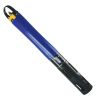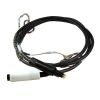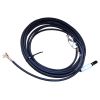YSI Cable Grip Kit
Features
- Sustained loading of 40 lbs.
- Corrosion-resistant 316 SS and Xenoy plastic construction
- 2-year warranty
- Expedited repair and warranty service
- Lifetime technical support
- More
Overview
The YSI Cable Grip Kit is designed to add redundant protection to your Field Cable, Flying Lead Field Cable, or Vented Flying Lead Field Cable for EXO and ProSwap Logger systems. Proper installation allows the 316 Stainless Steel (SS) parts to add additional support, and offers the best corrosion resistance currently available for high-fouling monitoring applications. The cable grip can serve many functions.
EXO Cables
Primary purpose is to act as a backup sonde retention system by clamping near the sonde connector end of the cable. It may also be used to provide strain relief for the connector (optional). The EXO cable connector is robust and does NOT require strain relief, but some users may opt to utilize this feature.
ProSwap Logger Cables
Provides a point of suspension or mounting for the ProSwap Logger by clamping near the connector end of the cable. This may be necessary to secure the cable for standalone applications. If connecting to an external power supply or DCP, the cable grip may be used as an optional retention system.
Grip Options for Cables
- 599951-01: 0.344 diameter cable grip for use with non-vented cables
- EXO Cables: 599008-x and 599040-x
- ProSwap Logger: 610151-x, 610152-x, 6101514-x, and 610155-x
- 599951-02: 0.360 diameter cable grip for use with vented cables
- EXO Cables: 599210-x
- ProSwap Logger: 610150-x and 610153-x
- Sustained Loading: 40 lb / 18.14 kg
- Max Short Term Loading (abrupt shock): 200 lb / 90.72 kg
In The News
Floating Global New Ideas: Buoy-Enabled Research at Florida Agricultural and Mechanical University’s School of the Environment
Florida Agricultural and Mechanical University (FAMU), based in Tallahassee, Florida, is the highest-rated public Historically Black College or University in the United States. FAMU’s School of the Environment (FAMU-SOE) offers BS and BA degrees in Environmental Studies, and BS, MS, and Ph.D. degrees in Environmental Science, with specialisms available in areas including Environmental Policy and Risk Management, Aquatic and Terrestrial Ecology, and Biomolecular Sciences. In 2021, FAMU-SOE deployed a NexSens CB-450 buoy in Apalachee Bay, a key oyster farming area around 30 miles south of Tallahassee. The buoy has quickly been incorporated into the curriculum, providing environmental insights for student research, the community, and beyond. Dr.
Read MoreMonitoring Habitat Suitability and Water Quality in Northwest Arkansas Springs
Northwest Arkansas has seen an economic, industrial, and population boom in recent years as a result of expanding businesses, which have created thousands of jobs in the region and the mass migration of employees and construction companies. However, with this growth has come rapid urbanization and the degradation of the natural landscape, specifically the freshwater springs that can be found throughout the region. These springs are critical habitat centers for native wildlife, home to threatened and endangered fish, and those that have yet to be listed. Zach Moran, Assistant Professor of Fisheries Science at Arkansas Technical University, is working to help monitor these habitats and provide key data that will hopefully inform future development in the region.
Read MoreThree Decades of Research at Acton Lake
A multi-disciplinary team at Miami University, Ohio, has been studying the environmental change at Acton Lake for over three decades. Using three different NexSens buoys over this time, the team has an incredible archive of data that is helping build a picture of Acton’s past, present, and future. Until recently, a NexSens CB-50 buoy was used alongside other environmental monitoring at Acton Lake. In May 2025, the Miami team deployed a new XB-200 buoy , future-proofing their ongoing monitoring using real-time buoy systems. Acton Lake, a small hypereutrophic reservoir in southwest Ohio, covers 2.4km² and has a maximum depth of about 8m. The dam was built in 1956, and the lake has a large agricultural watershed.
Read More




























